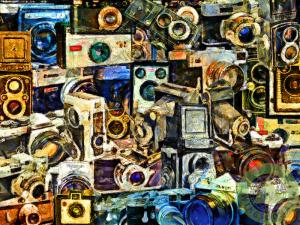Vintage Abstract Photography V3 By Wingsdomain Art And Photography

April 25th, 2015 - SF Bay Area, CA
Pick Here to Purchase Print, watermark will not show on print
or Pick HERE for more Hobbies and Collectibles Art and Photography
The forerunner to the photographic camera was the camera obscura. In the fifth century B.C., the Chinese philosopher Mo Ti noted that a pinhole can form an inverted and focused image, when light passes through the hole and into a dark area. Mo Ti is the first recorded person to have exploited this phenomenon to trace the inverted image to create a picture. Writing in the fourth century B.C., Aristotle also mentioned this principle. He described observing a partial solar eclipse in 330 B.C. by seeing the image of the Sun projected through the small spaces between the leaves of a tree. In the tenth century, the Arabic scholar Ibn al-Haytham (Alhazen) also wrote about observing a solar eclipse through a pinhole, and he described how a sharper image could be produced by making the opening of the pinhole smaller. English philosopher Roger Bacon wrote about these optical principles in his 1267 treatise Perspectiva. By the fifteenth century, artists and scientists were using this phenomenon to make observations. Originally, an observer had to enter an actual room, in which a pinhole was made on one wall. On the opposite wall, the observer would view the inverted image of the outside. The name camera obscura, Latin for "dark room", derives from this early implementation of the optical phenomenon. The term was first coined by mathematician and astronomer Johannes Kepler in his Ad Vitellionem paralipomena of 1604.
The use of photographic film was pioneered by George Eastman, who started manufacturing paper film in 1885 before switching to celluloid in 1889. His first camera, which he called the "Kodak," was first offered for sale in 1888. It was a very simple box camera with a fixed-focus lens and single shutter speed, which along with its relatively low price appealed to the average consumer. The Kodak came pre-loaded with enough film for 100 exposures and needed to be sent back to the factory for processing and reloading when the roll was finished. By the end of the 19th century Eastman had expanded his lineup to several models including both box and folding cameras.
-wikipedia
Get The Journal
Wingsdomain.com creates and sells quality unique fine art and photography prints. We serve the entire art and photography community including Designers, Decorators, Hotel Operators, Restaurant Owners, Retail Stores, Art Galleries, and all other trades, as well as for the weekend decorator wanting to enhance any space in their home. Wingsdomain art and photographs can already be seen in homes, offices, hotels, retail stores, restaurants, and galleries worldwide, and have been licensed to films and television shows. Volume discounts available. Licensing available for most art and photography. Email wingsdomain@hotmail.com for more details.
Join my Mailing List !
For $4.3 million you can get a Gursky. For $43 million you can get a Lichtenstein. And for just a tad under $120 million, you can get a Munch. Luckily for everyone else, there is Wingsdomain Art and Photography!
The Studio Q Project
Shop for Canvas Prints. Buy Canvas Prints. Canvas Prints for sale.
Shop for Framed Prints. Buy Framed Prints. Framed Prints for sale.
Shop for Metal Prints. Buy Metal Prints. Metal Prints for Sale.
Shop for Acrylic Prints. Buy Acrylic Prints. Acrylic Prints for sale.
Shop for Standard Prints. Buy Standard Prints. Standard Prints for sale.
Shop for Prints. Buy Prints. Prints for sale.
Shop for Posters. Buy Posters. Posters for sale.
Shop for Greeting Cards. Buy Greeting Cards. Greeting Cards for sale.
Shop for IPhone Cases. Buy IPhone Cases. Iphone Cases for sale.
Shop for Galaxy Cases. Buy Galaxy Cases. Galaxy Cases for sale.

